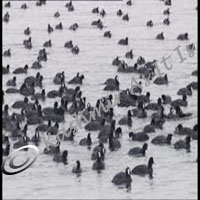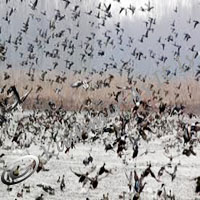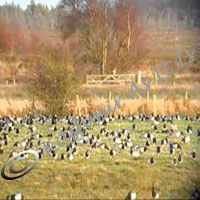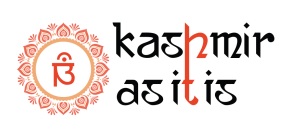The wetlands of the Kashmir Valley are rapidly shrinking due to the massive siltation and encroachment. This is posing a severe threat to thousands of local as well as migratory birds. Experts say that the continuous fall of water levels in wetlands will turn that into marsh killing all the flora and fauna. The wildlife authority is though trying ts best to preserve the wetlands by raising the bunds along the periphery to maintain the optimum water level. Also steps are being taken to aware the locals about the importance of wetlands and asking them to play a vital role in saving them.
There are 9 wetlands in the Kashmir Valley:
Hokersar – 13.75 Sq.Km
 Hokersar Wetland in Kashmir is filled with the migratory birds who prey on fish and insects in this protected territory. Migratory birds start their annual sojourn here in early September and stay until mid-February or early March. Uptil now around 7 lack migratory birds of 13 different species have reached Hokersar reserve. The commonly seen birds include – Geese, Shovelers, Red-crested pochards, White-eyed pochards, Common teals, Egrets, Wigeons, Coots and Greylags. Wildlife authorities say that many of the visiting species due to siltations and encroachments, which has already reduced this wetland to half of its actual size. To prevent the decrease in the number of the visiting species, wildlife authorities are also arranging artifial food for the birds. A check is always being kept on the Suitable habitat patterns, favorable conditions, circumstances and livelihood can ensure improved bird population.
Hokersar Wetland in Kashmir is filled with the migratory birds who prey on fish and insects in this protected territory. Migratory birds start their annual sojourn here in early September and stay until mid-February or early March. Uptil now around 7 lack migratory birds of 13 different species have reached Hokersar reserve. The commonly seen birds include – Geese, Shovelers, Red-crested pochards, White-eyed pochards, Common teals, Egrets, Wigeons, Coots and Greylags. Wildlife authorities say that many of the visiting species due to siltations and encroachments, which has already reduced this wetland to half of its actual size. To prevent the decrease in the number of the visiting species, wildlife authorities are also arranging artifial food for the birds. A check is always being kept on the Suitable habitat patterns, favorable conditions, circumstances and livelihood can ensure improved bird population.
Narkara – 3.25 Sq.Km
The Narkara Wetland in Kashmir receives its water supply from Doodhganga catchment and is surrounded by the paddy cultivation and willow plantation areas. Due to heavy encroachments, the considerable amount of marshy area has been converted into the solid land masses. Narkara wetland is the favorite habitat site for a number of water fowl species like Grelag goose, Ruddy shelduck, Pintail, Common teal, Mallard, Gadwal, Wigeon, Shoveller and Tufted duck. As per the census data the population of migratory birds has reduced from lacks to only 3,275 birds in winter season.
Manibugh – 4.50 Sq.Km

Manibugh Wetland in Kashmir was managed for organized shooting from November/ December till April. However this practise has been stopped from past few years as protection to the wetland and flora/fauna is proposed by the wildlife authorities. This wetland is now characterised by low water levels since they are surrounded by cultivation areas which washes organic and inorganic constituents in wetland.
Chatlam – 0.25 Sq.Km
Chatlam Wetland in Kashmir was initially a game reserve, however now it is being maintained by the fishries and fish farms. It is a spring fed wetland. The shores of this wetland are elevated due to the deposits of fine grained sand and loam. Migratory fowls are majorly found in these areas.
Mirgund – 4.00 Sq.Km
Mirgund Wetland in Kashmir is a shallow temporary wetland. The water supply for this wetland is Sukhna Nallah and other channels that are used to irrigate the adjacent paddy fields. This wetland is being extensively used for harvesting fodder and grazing livestock. It has fluvial type of fresh water origin.
Ajus – 1.00 Sq.Km
Shallabugh – 16.00 Sq.Km
Hygam – 7.25 Sq.Km
 Wetland of Hygam in Kashmir drains into Wular through Tarazoo. The main source of water for this wetland is Ningle Nallah and Babakul. This area is also used for hunter waterfowls.
Wetland of Hygam in Kashmir drains into Wular through Tarazoo. The main source of water for this wetland is Ningle Nallah and Babakul. This area is also used for hunter waterfowls.





